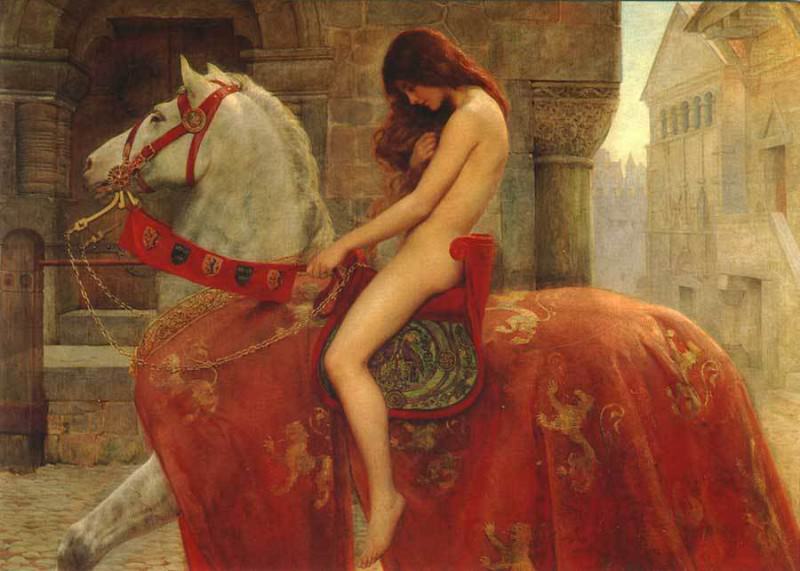Lady Godiva John Collier (1850-1934)
John Collier – Lady Godiva
Edit attribution
Download full size: 900×642 px (0,1 Mb)
Painter: John Collier
Location: Herbert Art Gallery, Coventry.
The year of creation is 1898, oil on canvas. Located at The Herbert Art Gallery & Museum, Coventry, UK. The artist belonged to the Pre-Raphaelite movement that emerged in English painting from the 1850s. They sought to move away from a mindless academism that idealized the image and was limited in its choice of subject matter. At the time it meant going against the Royal Academy of Arts, hence the great criticism.
Description of John Collier’s Lady Godiva
The year of creation is 1898, oil on canvas. Located at The Herbert Art Gallery & Museum, Coventry, UK.
The artist belonged to the Pre-Raphaelite movement that emerged in English painting from the 1850s. They sought to move away from a mindless academism that idealized the image and was limited in its choice of subject matter. At the time it meant going against the Royal Academy of Arts, hence the great criticism. One of the main features of the new current was the desire to paint people from nature.
The painting depicts a moment in a legendary story that took place in Coventry in the mid-11th century. The locals were supposedly suffering so much from exorbitant taxes that Lady Godiva came to her husband, the wealthy Earl Leofric, to beg for them. Being drunk, the man agreed on an impossible condition for her - to ride through the city naked. However, the noble lady put the needs of society above her pride and honor. The people loved her so much that on a certain day they did not go out into the streets, closing all the windows and doors. So, unnoticed by anyone and covered only by her hair, the maiden rode through town. However, this whole story is most likely a beautiful fiction.
Collier in his painting, unlike most authors, depicted the beautiful red-haired Godiva confused and frightened by the mad ride. Despite her act, she is graceful and innocent. The nakedness and fragility of her figure contrasts with the richly adorned harness and harness, the horse’s muscles, which are especially clearly drawn on the powerful neck. The painter has reflected many other details on the canvas with amazing precision. In the background, the uneven masonry and the scratched column look really ancient. The viewer sees every link of the gold chain and coats of arms on the reins, the magnificent pattern of purple and greenish-yellow on the saddle, the vegetal ornamentation of the braid and the golden English royal lions on the horse’s coverlet. Also of note is the magnificent color scheme, which transports to distant times, and the composition that makes you feel the slow movement of the rider.
Кому понравилось
Пожалуйста, подождите
На эту операцию может потребоваться несколько секунд.
Информация появится в новом окне,
если открытие новых окон не запрещено в настройках вашего браузера.
You need to login
Для работы с коллекциями – пожалуйста, войдите в аккаунт (open in new window).














COMMENTS: 5 Ответы
История о прекрасной жене правителя Ковентри графа Леофрика, вступившейся за изнывающих под тяжким бременем налогов жителей графства – одна из популярнейших в британском фольклоре. Впервые она появляется в конце XII века в сочинении Роджера Вендровера.
Согласно легенде, Леофрик обещал снизить налоги, если его жена проедет обнаженной на лошади по улицам Ковентри. Граф был уверен, что Годива не пойдет на это, но она решилась, хотя и схитрила немного, попросив жителей в назначенный день закрыть ставни и не выглядывать на улицу.
Леофрик сдержал слово и снизил налоги.
Джон Кольер изобразил на этой картине самый эффектный эпизод, когда обнаженная всадница проезжает по пустынным улицам города.
Текст о картине позаимствован у NADYNROM, её полный рассказ о жизни и творчестве Джона Кольера – здесь:
http://www.liveinternet.ru/community/2281209/post106219252/
spasibo bolshoe
странный муж
Осип МАНДЕЛЬШТАМ
С миром державным я был лишь ребячески связан,
Устриц боялся и на гвардейцев глядел исподлобья, –
И ни крупицей души я ему не обязан,
Как я ни мучал себя по чужому подобью.
С важностью глупой, насупившись, в митре бобровой,
Я не стоял под египетским портиком банка,
И над лимонной Невою под хруст сторублевый
Мне никогда, никогда не плясала цыганка.
Чуя грядущие казни, от рева событий мятежных
Я убежал к нереидам на Черное море,
И от красавиц тогдашних, от тех европеянок нежных
Сколько я принял смущенья, надсады и горя!
Так отчего ж до сих пор этот город довлеет
Мыслям и чувствам моим по старинному праву?
Он от пожаров еще и морозов наглее,
Самолюбивый, проклятый, пустой, моложавый.
Не потому ль, что я видел на детской картинке
Леди Годиву с распущенной рыжею гривой,
Я повторяю еще про себя под сурдинку:
“Леди Годива, прощай! Я не помню, Годива... ”
这张也太糊了
You cannot comment Why?
The setting appears to be a medieval town square or street. To the left, a stone building with an arched entryway and ornate columns is visible. To the right, a row of weathered buildings with arched windows and balconies suggests an urban environment. The overall color palette is dominated by rich reds, earthy browns, and muted golds, creating a sense of historical grandeur and solemnity.
The subtext of the painting revolves around the legend of Lady Godiva. According to the story, she rode naked through the streets of Coventry to protest her husbands oppressive taxation of his tenants. The painting captures a moment of her legendary ride, emphasizing her vulnerability and courage. The nudity, while the central element of the legend, is portrayed here with a sense of modesty and introspection rather than overt sensuality. Her downcast gaze and the somber atmosphere suggest the gravity of her protest and the potential consequences of her act. The opulent attire of the horse, in contrast to her nakedness, may symbolize the wealth and power of her husband, which she is defying through her sacrifice. The painting thus explores themes of sacrifice, social justice, female agency, and the tension between public duty and personal virtue.